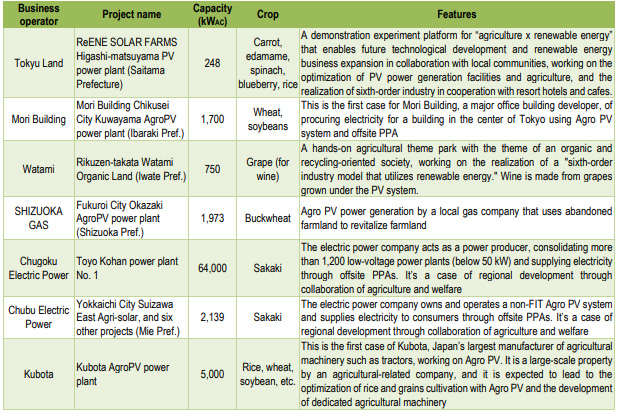The combination of PV power generation and agriculture is called “farming-type” PV power generation (PV power generation while continuing farming) or “solar sharing” in Japan, while globally it is called Agrivoltaics (Agro PV or Agri PV). Agro PV is attracting worldwide attention due to its multifunctionality to provide multiple ecosystem services such as agriculture, biodiversity, and green spaces, while also providing power generation functions, and its introduction is progressing.
Agro PV is recognized around the world to be maximizing the synergies of the three security factors of energy, food, and the environment, as well as providing various benefits such as improved land use and land productivity. Beyond the environment, promoting sustainable development in agricultural areas is beneficial to rural economies by creating jobs, generating income and tax revenues for local communities, and providing diverse incomes for farmers and landowners. In this way, Agro PV is regarded as important as a foundation for a sustainable and prosperous future, and research and development (R&D), demonstration, and early introduction has been actively supported to realize and optimize both agriculture and power generation.
In Europe in particular, the Common Agricultural Policy (CAP) focuses on the nine goals for sustainable agriculture practice as follows: 1) fair incomes; 2) increased competitiveness; 3) food value chains; 4) climate change mitigation; 5) environmental protection; 6) landscapes and biodiversity; 7) generational change; 8) creation of vibrant agricultural communities and 9) ensuring quality of food and health. Agro PV projects are underway as one of the key tools to achieve these goals. The Fraunhofer Institute for Solar Energy Systems (ISE) (Germany) published an interim report on an Agro PV demonstration project in April 2024. As a result of multiple demonstration researches over a two-year period, it was reported that PV modules installed above farmland contributed to an increase in crop yields, and that irrigation water use was reduced by 50% and pesticides were saved by 70%. As for the amount of power generated, it is reported that over 20% more power generation than expected was obtained due to the evaporation of water and the cooling effect of backside ventilation. In terms of the PV module installation format, new technologies such as angle-adjustable types that can adjust solar radiation and prevent frost damage, solar tracking types that can increase power generation while equalizing light shed on crops, and translucent types for greenhouses that can adjust the amount of light and select light wavelengths are being demonstrated, and modeling tools for agriculture and PV power generation for optimization are also being developed.
In addition, systematic R&D is being carried out with support in Italy, France, the Netherlands, the USA, South Korea, Taiwan, India, and other countries. Under such circumstances, Japan is positioned as a developed country that has started working on solar sharing or Agro PV for the first time in the world, and has accumulated a track record of introduction with various agricultural crops.
In Japan, after the Ministry of Agriculture, Forestry and Fisheries (MAFF) issued a notice in 2013 regarding permission to convert farmland for installing Agro PV systems, efforts to promote Agro PV began, and since then, the introduction has gradually increased due to deregulation and support for introduction, and it is estimated that the cumulative Agro PV installed capacity has exceeded 1 GW based on the records of farmland conversion permits. Until now, many small-scale Agro PV power plants have been installed in Japan due to the fact that many of the Agro PV power plants in Japan have been installed by an individual farmer who is working on advanced initiatives, and small-scale (low-voltage) Agro PV systems have been given preferential treatment under the Feed-in Tariff (FIT) and Feed-in Premium (FIP) programs. However, in recent years, as shown in Table 1, large companies have also entered the market, and they have begun to evolve from just being the conventional “farming-type” PV power generation to the “prosperous” Agro PV power generation (PV power generation which prospers agriculture), which leads to the development of agriculture and rural areas. There are also an increasing number of cases in which companies form agricultural corporations to consolidate farmland and engage in large-scale Agro PV power generation of with a power generation capacity of 2,000 kW or more, revitalize degraded farmland into farmland, and supply renewable electricity to consumers who need it through offsite PPAs instead of selling all of the generated electricity under the FIT program. In addition, companies that operate supermarkets and resort hotels have begun efforts to realize both the sixth-order industry and decarbonized management by using crops and electricity generated by Agro PV power generation.
In May 2024, the Basic Act on Food, Agriculture and Rural Areas, which is said to be the constitution of agricultural policy, was revised. With food security as its basic principle, the revised Act includes the reduction of environmental impact, harmony with the environment, improvement of productivity, and rural development. Based on these principles, it is necessary to shift Agro PV power generation from the conventional “farming type” to the “prosperous type” and show by 2030 that PV power generation prospers agriculture by accumulating achievements. From 2030 onwards, full-scale PV introduction to farmland is expected to enable agriculture and farmland to achieve both agricultural development and energy security as a supplier of food and electricity and improve the food self-sufficiency rate. As the number of suitable sites for PV installations is decreasing, it is essential to have coordinated efforts led by the Ministry of Agriculture, Forestry and Fisheries (MAFF), the Ministry of Economy, Trade and Industry (METI), and the Ministry of the Environment (MoE) in order to expand the way to the use of farmland as new suitable sites for PV power generation. It is strongly hoped that PV power generation will become an essential part of next-generation agriculture and contribute to the revitalization of agriculture and rural areas.
Table 1 Examples of new initiatives of Agro PV power generation by large companies

